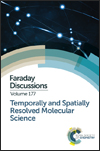Dynamics of the chemical bond: inter- and intra-molecular hydrogen bond†
Abstract
In this discussion, we show that a static definition of a ‘bond’ is not viable by looking at a few examples for both inter- and intra-molecular hydrogen bonding. This follows from our earlier work (Goswami and Arunan, Phys. Chem. Chem. Phys. 2009, 11, 8974) which showed a practical way to differentiate ‘hydrogen bonding’ from ‘van der Waals interaction’. We report results from ab initio and atoms in molecules theoretical calculations for a series of Rg⋯HX complexes (Rg = He/Ne/Ar and X = F/Cl/Br) and ethane-1,2-diol. Results for the Rg⋯HX/DX complexes show that Rg⋯DX could have a ‘deuterium bond’ even when Rg⋯HX is not ‘hydrogen bonded’, according to the practical criterion given by Goswami and Arunan. Results for ethane-1,2-diol show that an ‘intra-molecular hydrogen bond’ can appear during a normal mode vibration which is dominated by the O⋯O stretching, though a ‘bond’ is not found in the equilibrium structure. This dynamical ‘bond’ formation may nevertheless be important in ensuring the continuity of electron density across a molecule. In the former case, a vibration ‘breaks’ an existing bond and in the later case, a vibration leads to ‘bond’ formation. In both cases, the molecule/complex stays bound irrespective of what happens to this ‘hydrogen bond’. Both these cases push the borders on the recent IUPAC recommendation on hydrogen bonding (Arunan et al. Pure. Appl. Chem. 2011, 83 1637) and justify the inclusive nature of the definition.
- This article is part of the themed collection: Temporally and Spatially Resolved Molecular Science

 Please wait while we load your content...
Please wait while we load your content...